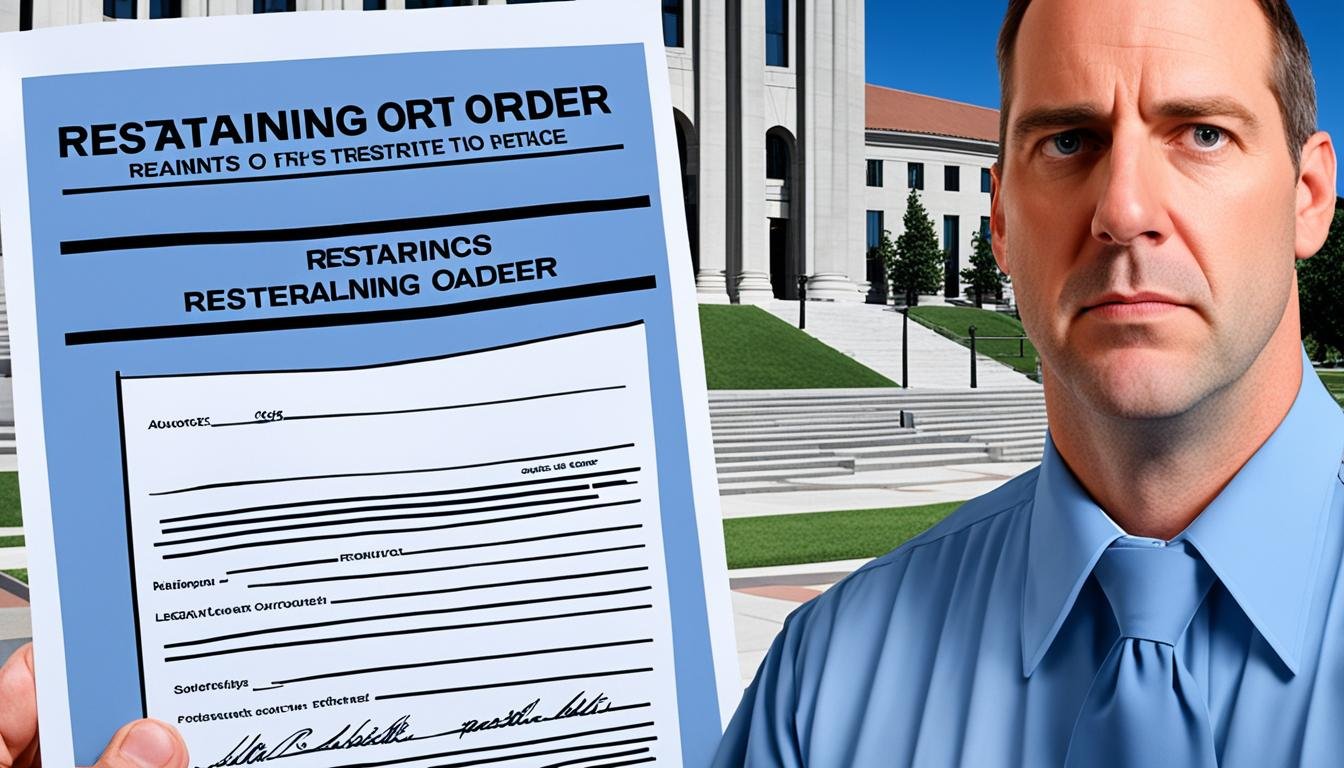In California, there are four main types of restraining orders1. These include domestic violence, workplace violence, civil harassment, and elder/dependent abuse restraining orders1. These orders can affect the restrained person a lot, like taking away gun rights, affecting jobs, licenses, and even where they can live1.
A restraining order, or protective order, is a key legal tool2. It helps protect you from physical, sexual, or emotional abuse, threats, stalking, or harassment2. It can stop the restrained person from contacting you, visiting certain places, or owning guns. This gives you peace of mind and protection2.
If you’re facing abuse, knowing about restraining orders in California is key2. We’ll cover the different types, how to get them, what protection they offer, and what happens if you break them2.
Key Takeaways
- Restraining orders in California protect you from abuse, threats, stalking, or harassment.
- There are many types of restraining orders, like domestic violence and civil harassment.
- These orders can greatly affect the restrained person, like taking away gun rights and causing job and housing issues.
- It’s important to know how to get a restraining order to protect yourself.
- Talking to a restraining order defense attorney can help you understand your legal options.
What is a Restraining Order in California?
A restraining order is a court order that protects people from abuse, harassment, or threats3. It’s a way to keep someone safe from harm. In California, there are different kinds of restraining orders for various types of abuse.
Definition and Purpose
A restraining order in California stops someone, called the “restrained person,” from doing certain things to another, the “protected person”4. Its main goal is to legally stop the restrained person from hurting, contacting, or talking to the protected person4.
Types of Restraining Orders
California has four main kinds of restraining orders:3
- Domestic Violence Restraining Order
- Elder or Dependent Adult Abuse Restraining Order
- Civil Harassment Restraining Order
- Workplace Violence Restraining Order
Each restraining order has its own rules and offers different levels of protection3. Breaking a restraining order in California can lead to jail, fines, or both, and more4.
To get a restraining order in California, you must go through a legal process4. This includes filling out forms, filing them with the court, and possibly going to a hearing4. Sometimes, you can get a temporary order right away based on what you say4.

It’s key to know the details of each restraining order type and what they protect to make the right choice and stay safe345.
Domestic Violence Restraining Orders California
In California, you can ask for a domestic violence restraining order if you’ve been abused by someone close to you. This includes a spouse, partner, ex, someone you’ve dated, or a family member6. The abuse can take many forms, like physical, sexual, emotional, economic, or psychological ones6.
These orders can keep you safe from more abuse. They can stop the person from contacting or harassing you, keep them away, or make them leave your home6. A judge can also order them to pay you, take care of your kids, or give you custody6.
Eligibility Requirements
You can file for a restraining order against someone you’re married to, used to be married to, dating, or close to by blood7. You can also file against parents of your child or people who live with you7. You only need to prove it’s more likely than not that you were abused7. This can be done with things like medical records, witness stories, and messages you exchanged7.
Protection Offered
A restraining order in California can stop the person from contacting you in many ways8. This includes no personal contact, phone calls, emails, or social media chats8. The court might also take away any guns they own8. These orders can last up to 5 years, giving you a long-term safety net8.
If someone breaks a restraining order in California, they could face serious charges8. These can be anything from a misdemeanor to a felony, with jail time of up to a year or even three years in prison8. It’s important to know the legal risks of ignoring a restraining order in California.

Civil Harassment Restraining Orders California
If you’re facing harassment, stalking, abuse, or threats from someone not in your family or home circle, like a neighbor or coworker, you can get a civil harassment restraining order in California9. These orders protect you just like domestic violence restraining orders do, with rules about personal conduct and staying away9.
A judge can give you a civil harassment restraining order if someone has harassed, stalked, threatened, or harmed you emotionally or physically9. The order can stop contact, harassment, stalking, or threats. It can also make the person stay away, limit their distance from you, and stop them from owning guns or ammo9.
| Types of Restraining Orders in California |
|---|
|
Getting a civil harassment restraining order usually takes weeks, but can take months if the case is complex9. In most places, you don’t talk directly to a judge at first. But, a decision on temporary protection is made quickly, often the same day or the next day after you submit the forms9.
If a temporary restraining order is given, the person it’s against must follow all orders. Not following them can lead to arrest and criminal charges9. When responding to a restraining order request, you tell the judge if you agree or disagree. You can get help from a court Self-Help Center or hire a lawyer10.
The court sets a hearing date, usually within 3 weeks of filing, to decide if a longer-term restraining order is needed, lasting up to 5 years9. It’s important to be at the court date to argue against the restraining order9.
“Under California law, a person who has suffered harassment may seek a temporary restraining order and an injunction prohibiting harassment.”10
Restraining orders California: Process and Requirements
Getting a restraining order in California means following a specific process to protect you from abuse11. There are two types: temporary and permanent. Permanent ones can last for a long time, even forever11. They can include rules like supervised visits and stay-away orders11.
Filing for a Restraining Order
To get a restraining order, you must fill out court forms and provide evidence12. Sometimes, you might start with a temporary order before a permanent one11. Getting a permanent order means going through court, hearings, and the abuser might contest it11.
Evidence and Documentation
You’ll need to gather evidence like police reports and medical records for your restraining order application12. The strength of your evidence is crucial for the judge’s decision11. To get a permanent order, you must show a link to the abuser and evidence of harm or threats11.
A permanent order can affect many areas of life, like spousal support and property rights11. Breaking the order can lead to arrest and more serious consequences11. Violations can result in fines and jail time, or even more severe penalties11.
Remember, violating a permanent order doesn’t directly affect your immigration status unless it’s for serious crimes11. You can ask to have the order lifted through court if you follow the rules11.
“The strength of the evidence you present will be a key factor in the judge’s decision to grant or deny the restraining order.”
Consequences of Violating a Restraining Order
Breaking a restraining order in California can lead to serious legal trouble for the person it protects, known as the “restrained person.”1314 Not following a restraining order is a crime that can bring fines, jail time, and harsher penalties if there’s physical harm15.
Legal Penalties
In California, breaking a restraining order is usually a misdemeanor. This can result in fines up to $1,000 and/or up to one year in county jail1314. But, if the violation causes physical injury, the penalties can be worse, with fines up to $2,000 and at least 30 days in jail1315. If there’s violence in the next seven years, the punishments can get even tougher, including up to one year in county jail or state prison13.
For felony convictions of violating restraining orders, the penalties can be severe. Offenders might face up to three years in state prison and fines up to $10,0001415. It’s the job of each county’s prosecuting agencies to enforce protective orders and deal with violations13.
Impact on Ownership and Rights
Breaking a restraining order in California can also affect someone’s right to own or carry guns13. It can also impact someone’s immigration status if they’re trying to get a green card or visa13.
The court might order the restrained person to pay money to domestic violence shelters or make restitution to victims up to $5,00013. The court will check if the defendant can afford these fines and orders13.
It’s very important to get legal help from a skilled protective order lawyer if you’re accused of violating a restraining order in California. They can guide you through the legal process and try to lessen the impact1415.
Defending Against a Restraining Order
If you’ve been served with a restraining order in California, take it seriously and prepare well for the court hearing16. You need to collect all important evidence and documents. Also, list potential witnesses and work with a skilled lawyer for a strong defense17.
It’s key to stay calm and follow the order’s rules until the hearing17. Your lawyer can guide you through legal steps and suggest strategies. This could include showing you didn’t mean to do anything wrong or questioning the evidence against you16.
Preparing for the Hearing
To get ready for the hearing, do these steps:
- Collect all evidence and documents that help your case, like messages, records, or stories from witnesses16.
- Make a list of people who can speak for you and work with your lawyer to prepare their stories16.
- Understand the restraining order’s rules and what it says you can and can’t do17.
- Work with your lawyer to plan a strong defense. This could mean showing you didn’t know or mean to do anything wrong, or questioning the evidence16.
The hearing’s outcome can greatly affect you, including facing criminal charges and losing rights and reputation17. So, it’s vital to be serious and defend yourself well18.
“With proactive legal help, Californians can work out deals with prosecutors. This might mean getting lighter charges by pleading guilty or no contest before trial.”
With a good lawyer and the right steps, you can boost your chances of defending against a restraining order in California16. This can protect your rights and lessen the long-term effects on your life17.
| Key Considerations | Potential Strategies |
|---|---|
| Lack of intent or awareness | Show the court you didn’t know about the restraining order when you allegedly broke it. |
| Insufficient evidence | Question the prosecution’s evidence. Look for mistakes or wrong information that could weaken or drop charges. |
| Plea bargaining | Talk with prosecutors to get lighter charges by pleading guilty or no contest before trial. |
Conclusion
Restraining orders in California are key legal tools that protect people from domestic violence, harassment, or threats. If you need one or have been given one, knowing about the types, who can get them, and the legal steps is crucial. With the help of skilled lawyers like those at businesslawyersirvine.com, you can get through the process and protect your rights19.
Breaking a restraining order can lead to big trouble, like a $1,000 fine and a year in jail for the first time20. If it’s a more serious crime, you could face up to three years in state prison and a $10,000 fine20. It’s important to follow the court’s orders to avoid more legal trouble20.
Learning about the different kinds of restraining orders, like and , and their legal details helps you make smart choices to protect yourself and your loved ones. The experts at businesslawyersirvine.com are here to guide you and make sure your rights are respected19.
FAQ
What is a restraining order?
What types of restraining orders are available in California?
Who can obtain a domestic violence restraining order in California?
What kind of protection can a domestic violence restraining order provide in California?
Who can obtain a civil harassment restraining order in California?
What is the process for filing for a restraining order in California?
What kind of evidence is needed to support a restraining order request in California?
What are the consequences of violating a restraining order in California?
How can someone defend against a restraining order in California?
Source Links
- https://www.enkanter.com/article/does-a-restraining-order-go-on-your-record-in-california
- https://www.sandiegodivorceattorneysblog.com/types-of-restraining-orders-in-california/
- https://www.courts.ca.gov/1260.htm
- https://www.shouselaw.com/ca/defense/laws/california-restraining-order/
- https://www.orangecountyfamilylaw.com/blog/what-proof-do-you-need-for-restraining-order-in-california/
- https://selfhelp.courts.ca.gov/DV-restraining-order
- https://thenieveslawfirm.com/what-evidence-do-i-need-for-a-restraining-order/
- https://www.shouselaw.com/ca/defense/laws/domestic-violence/restraining-order/
- https://selfhelp.courts.ca.gov/CH-restraining-order
- https://www.sdcourt.ca.gov/sdcourt/civil2/civilrestrainingorder
- https://www.leahlegal.com/practice-areas/domestic-violence/restraining-orders/permanent-restraining-order
- https://www.edgarfamilylaw.com/blog/what-proof-do-you-need-for-a-restraining-order-in-california/
- https://www.shouselaw.com/ca/defense/penal-code/273-6/
- https://www.ceclaw.net/violation-of-restraining-order-california/
- https://www.wklaw.com/penalties-for-violating-a-restraining-order-in-california/
- https://www.eastbaylawpractice.com/blog/2023/march/how-to-defend-against-a-restraining-order-violat/
- https://www.steindefense.com/fight-restraining-order-california/
- https://minellalawgroup.com/services/restraining-orders/defending-a-domestic-violence-restraining-order/
- https://www.courts.ca.gov/documents/DVRO-benchguide.pdf
- https://www.hashemilaw.com/understanding-the-difference-between-restraining-orders-and-protective-orders-in-california/

